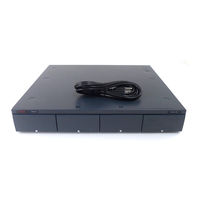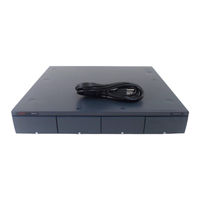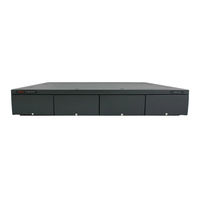Avaya IP500 V2 Manuals
Manuals and User Guides for Avaya IP500 V2. We have 4 Avaya IP500 V2 manuals available for free PDF download: Installation Manual
Avaya IP500 V2 Installation Manual (442 pages)
Table of Contents
-
-
-
-
Unpacking77
-
Grounding92
-
-
ETR Phones99
-
DS Phones99
-
TCM Phones100
-
IP/SIP Phones100
-
-
6 On-Boarding
117-
On-Boarding118
-
-
-
-
-
-
Port Connection173
-
-
So8 BRI Module174
-
Snmp177
-
AUX Button181
-
Reset Button181
-
-
IP500 Unpacking190
-
Applying Power196
-
Adding Licences201
-
Rack Mounting204
-
Wall Mounting205
-
Grounding208
-
-
IP500 Base Cards217
-
Analog Phone221
-
Digital Station227
-
ETR6 Card228
-
VCM232
-
-
BRI Trunk Cards237
-
PRI Trunk Cards238
-
-
Analog Trunk 16241
-
BRI So8243
-
Phone 16/30252
-
-
Feature Keys254
-
-
Analog Trunk 16266
-
Digital Station270
-
Phone V2272
-
Phone274
-
So8276
-
-
Mounting Kits278
-
Phones279
-
9611G327
-
9620L, 9620C328
-
9621G330
-
9630G331
-
9640, 9640G333
-
9641G335
-
9650, 9650C336
-
Etr 6, Etr 6D339
-
D100 Series340
-
Etr 18, Etr 18D341
-
Etr 34D342
-
M7100343
-
M7100N343
-
M7208344
-
M7208N344
-
M7310345
-
M7310N345
-
M7324346
-
M7324N346
-
T7000347
-
T7100347
-
T7208348
-
T7316349
-
T7316E350
-
T7406, T7406E351
-
T3 Classic352
-
T3 Comfort353
-
T3 Compact354
-
-
Phone Add-Ons355
-
Rim356
-
Bm32358
-
Dbm32359
-
Eu24360
-
Eu24Bl361
-
KLM Module362
-
Smb24363
-
T3 Dss364
-
T7316E KEM365
-
Xm24366
-
-
-
Dect R4368
-
Applications369
-
Contactstore371
-
-
Monitor374
-
Softconsole378
-
Tapi381
-
Voicemail Pro382
-
IP Office Ports384
-
Physical Ports387
-
Cables388
-
ANALOG Port390
-
AUDIO Port390
-
BRI Port (So)391
-
BRI Port (To)392
-
DC I/P Port393
-
DS Ports (RJ45)393
-
EF Port394
-
ETR Port394
-
EXPANSION Port395
-
EXT O/P Port395
-
LAN Port396
-
PF Port397
-
PHONE (POT) Port398
-
PRI Port399
-
RS232 Port (DTE)400
-
TCM Port (RJ21)401
-
TCM Port (RJ45)401
-
-
Licences402
-
-
Taa421
-
Advertisement
Avaya IP500 V2 Installation Manual (426 pages)
Table of Contents
-
-
-
Unpacking75
-
Grounding91
-
-
ETR Phones98
-
DS Phones98
-
TCM Phones99
-
-
-
Port Connection137
-
-
So8 BRI Module138
-
Snmp141
-
Reset Button145
-
AUX Button145
-
-
-
Card Shutdown170
-
Card Startup171
-
System Shutdown172
-
-
-
IP500 Unpacking178
-
Applying Power184
-
Adding Licences189
-
Rack Mounting192
-
Wall Mounting194
-
Grounding197
-
-
IP500 Base Cards207
-
Analog Phone211
-
Digital Station216
-
ETR6 Card217
-
VCM220
-
-
BRI Trunk Cards224
-
PRI Trunk Cards225
-
-
Analog Trunk 16228
-
Bri So8230
-
Phone237
-
-
Feature Keys239
-
-
Analog Trunk 16251
-
Digital Station255
-
Phone V2257
-
Phone259
-
So8261
-
-
Mounting Kits263
-
Phones265
-
9611G314
-
9620L, 9620C315
-
9621G317
-
9630G318
-
9640, 9640G320
-
9641G322
-
9650, 9650C323
-
Etr 6, Etr 6D326
-
Etr 18, Etr 18D327
-
Etr 34D328
-
M7100329
-
M7100N329
-
M7208330
-
M7208N330
-
M7310331
-
M7310N331
-
M7324332
-
M7324N332
-
T7000333
-
T7100333
-
T7208334
-
T7316335
-
T7316E336
-
T7406, T7406E337
-
T3 Classic338
-
T3 Comfort339
-
T3 Compact340
-
Phone Add-Ons341
-
Rim342
-
Bm32344
-
Dbm32345
-
Eu24346
-
Eu24Bl347
-
KLM Module348
-
Smb24349
-
T3 Dss350
-
T7316E KEM351
-
Xm24352
-
Dect R4354
-
Applications355
-
Contactstore357
-
Manager359
-
Monitor360
-
Phone Manager362
-
Softconsole364
-
Softphone365
-
Tapi367
-
Voicemail Pro368
-
IP Office Ports371
-
-
Physical Ports375
-
Cables376
-
ANALOG Port378
-
AUDIO Port378
-
BRI Port (So)379
-
BRI Port (To)380
-
DC I/P Port381
-
DS Ports (RJ45)381
-
EF Port382
-
RS232 DTE Port382
-
ETR Port383
-
EXPANSION Port384
-
EXT O/P Port384
-
LAN Port385
-
PF Port386
-
PHONE (POT) Port387
-
PRI Port389
-
TCM Port (RJ21)390
-
-
Licences391
-
Upgrade Licenses393
-
Trunk Licensing394
-
User Licenses396
-
Trial Licenses405
-
Other Licenses406
-
Taa406
Avaya IP500 V2 Installation Manual (144 pages)
IP Office Essential Edition PARTNER Version Installation Manual
Brand: Avaya
|
Category: Telephone System
|
Size: 1.45 MB
Table of Contents
-
-
SD Cards12
-
Base Cards13
-
Trunk Cards15
-
-
-
-
Reset Button75
-
AUX Button75
-
-
-
Card Startup93
-
-
Control Unit96
-
SD Card98
-
Base Cards99
-
Analog Phone101
-
Digital Station102
-
ETR6 Card103
-
-
Trunk Cards106
-
PRI Trunk Cards108
-
-
Digital Station110
-
Phone Module112
-
-
Mounting Kits114
-
Telephones115
-
Etr6/Etr6D119
-
Etr18/Etr18D120
-
Etr34/Etr34D122
-
Phone Add-Ons124
-
-
Licences125
-
Physical Ports126
-
ANALOG Port127
-
Audio Port127
-
DC I/P Port127
-
DS Ports127
-
EF Port128
-
ETR Port128
-
Expansion Port128
-
EXT O/P Port128
-
LAN Port129
-
PF Port130
-
Phone (POT) Port130
-
PRI Port131
-
RS232 DTE Port132
-
-
Advertisement
Avaya IP500 V2 Installation Manual (71 pages)
Embedded Voicemail Installation
Table of Contents
-
-
-
Visual Voice34
-
-
-
-
Softconsole51
-
Short Codes52
-
Dial by Name54
Advertisement



